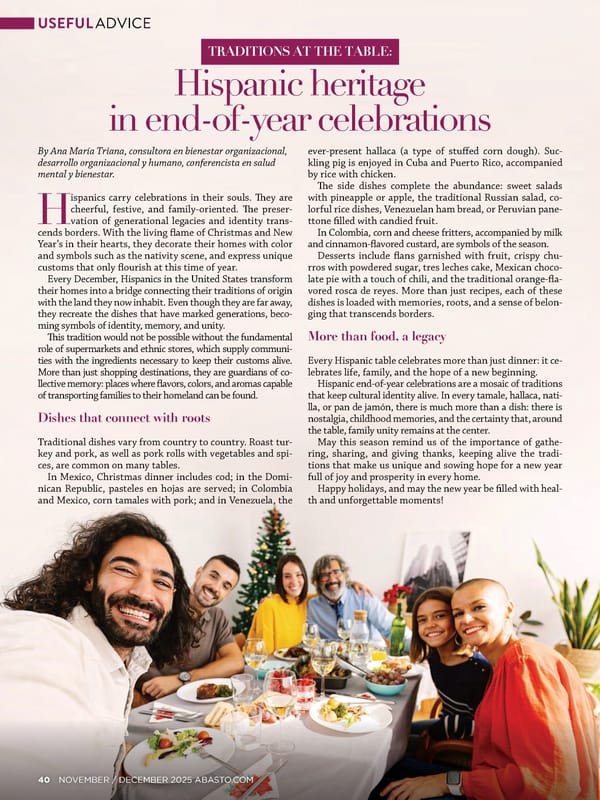40�NOVEMBER / DECEMBER 2025 ABASTO.COM By Ana María Triana, consultora en bienestar organizacional, desarrollo organizacional y humano, conferencista en salud mental y bienestar. H ispanics carry celebrations in their souls. Tey are cheerful, festive, and family-oriented. Te preser- vation of generational legacies and identity trans- cends borders. With the living fame of Christmas and New Year’s in their hearts, they decorate their homes with color and symbols such as the nativity scene, and express unique customs that only fourish at this time of year. Every December, Hispanics in the United States transform their homes into a bridge connecting their traditions of origin with the land they now inhabit. Even though they are far away, they recreate the dishes that have marked generations, beco- ming symbols of identity, memory, and unity. Tis tradition would not be possible without the fundamental role of supermarkets and ethnic stores, which supply communi- ties with the ingredients necessary to keep their customs alive. More than just shopping destinations, they are guardians of co- llective memory: places where favors, colors, and aromas capable of transporting families to their homeland can be found. Dishes that connect with roots Traditional dishes vary from country to country. Roast tur- key and pork, as well as pork rolls with vegetables and spi- ces, are common on many tables. In Mexico, Christmas dinner includes cod; in the Domi- nican Republic, pasteles en hojas are served; in Colombia and Mexico, corn tamales with pork; and in Venezuela, the ever-present hallaca (a type of stufed corn dough). Suc- kling pig is enjoyed in Cuba and Puerto Rico, accompanied by rice with chicken. Te side dishes complete the abundance: sweet salads with pineapple or apple, the traditional Russian salad, co- lorful rice dishes, Venezuelan ham bread, or Peruvian pane- ttone flled with candied fruit. In Colombia, corn and cheese fritters, accompanied by milk and cinnamon-favored custard, are symbols of the season. Desserts include fans garnished with fruit, crispy chu- rros with powdered sugar, tres leches cake, Mexican choco- late pie with a touch of chili, and the traditional orange-fa- vored rosca de reyes. More than just recipes, each of these dishes is loaded with memories, roots, and a sense of belon- ging that transcends borders. More than food, a legacy Every Hispanic table celebrates more than just dinner: it ce- lebrates life, family, and the hope of a new beginning. Hispanic end-of-year celebrations are a mosaic of traditions that keep cultural identity alive. In every tamale, hallaca, nati- lla, or pan de jamón, there is much more than a dish: there is nostalgia, childhood memories, and the certainty that, around the table, family unity remains at the center. May this season remind us of the importance of gathe- ring, sharing, and giving thanks, keeping alive the tradi- tions that make us unique and sowing hope for a new year full of joy and prosperity in every home. Happy holidays, and may the new year be flled with heal- th and unforgettable moments! Hispanic heritage in end-of-year celebrations TRADITIONS AT THE TABLE: 40�NOVEMBER / DECEMBER 2025 ABASTO.COM USEFUL ADVICE
 Abasto Magazine November/December 2025 ENGLISH Page 39 Page 41
Abasto Magazine November/December 2025 ENGLISH Page 39 Page 41